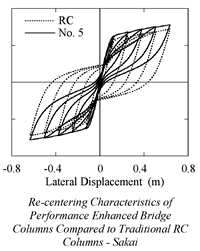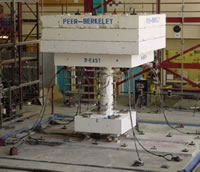| Project Title/ID Number |
Test of Enhanced Performance
Post Tensioned Columns—5342003 |
| Start/End Dates |
10/1/03—9/30/04 |
| Project Leader |
Stephen Mahin (UCB/F) |
| Team Members |
Junichi Sakai (UCB/GS) |
F=faculty; GS=graduate student; US=undergraduate student; PD=post-doc; I=industrial
collaborator; O=other
Click on images to enlarge in a new window
1. Project Goals/Objectives:
The overall goal of this study is to examine and assess various design
concepts for enhancing the seismic performance of new bridge structures
of the type being considered by PEER. Promising design details will be
assessed though dynamic shaking table tests as well as through more extensive
nonlinear dynamic analyses using the OpenSees computational platform. In
particular, the potential for reducing residual displacements of bridges
following severe earthquakes will be examined through the use of special
plastic hinge regions containing combinations of un-bonded, pre-stressed
and mild reinforcement. Other design approaches utilizing high performance
concrete, foundation details that permit rocking behavior, or other enhancements
will be examined in concert with others working within the PEER Center.
The PEER PBEE methodology will be utilized to quantify the benefits of
these enhanced systems in comparison with conventional bridge construction
in use today. The goal of this project would be to demonstrate the value
of the PEER methodology for a specific application, and thereby to accelerate
the adoption of new bridge design technologies into practice.
2.
Role of this project in supporting PEER’s mission
(vision):
Through this project, the PBEE methodology will be further developed
and tested. This research will demonstrate how the PBEE methodology can
be applied to quantitatively assess the enhanced seismic performance
of a new innovative bridge system. In this case the focus will be to
evaluate the extent to which reductions in post-earthquake residual displacements
and concrete spalling contribute to improved overall performance of the
bridge.
3. Methodology Employed:
An integrated analytical and experimental approach has been adopted.
Various PEER PBEE research results related to bridge structures are being
examined along with current research by the PI and other investigators
worldwide to identify promising methods of enhancing bridge performance.
The primary focus of these investigations will be to mitigate the substantial
residual displacements that tend to occur in modern bridges when large
inelastic deformations occur during severe earthquake shaking. These
residual displacements have an important impact on post-earthquake operability
of bridge structures, and repair costs. In addition, opportunities to
work with others within PEER to explore design solutions for other behavioral
aspects that adversely affect overall performance, such as spalling and
foundation damage.

The initial thrust of this work has been focused on
shaking table testing of a lightly reinforced bridge column specimen
with un-bonded post-tensioning.
The supervising PI has constructed an identical companion specimen
with conventional reinforced concrete construction as part of YR 6 PEER
project.
Comparison of test results for the conventional and enhanced columns
with that predicted by the underlying design methodology and the OpenSees
analytical platform will provide valuable data for assessing this approach.
It
is planned to work closely with other investigators working on this
subject to identify additional test specimens. For example, Dr. Billington
is assessing DM/DV and EDP/DM relationships for bridge piers containing
un-bonded post-tensioned reinforcement and high performance, cement-based,
ductile concrete, and Dr. Stojadinovic is carrying our extensive
simulations
to understand the contribution of various structural and ground motion
characteristics to bridge fragilities. Drs. Martin, Kutter and Hutchinson
have examined the geotechnical aspects of foundation rocking on shallow
foundations. Discussions with these and other PEER investigators
will help identify additional specimens. Based on current results, it
is
expected that two specimens would be constructed: one with a steel
jacket providing
confinement, and the other with improved details in the plastic hinge
region (for example, using high performance concrete, un-bonded mild
reinforcement, modified spiral reinforcement details, etc.). It is
expected that the specimens will be designed and constructed in year
7. Testing
and follow-on analyses will be done in year 7 and 8.
Analytical studies
have been carried out to examine and improve:
-
The ability of OpenSees
to simulate observed performance, and
-
Methods used for proportioning
and detailing enhanced performance columns for a variety of periods
and structural configurations.
4. Brief Description of past year’s accomplishments
(Year 6) & more detail on expected Year 7 accomplishments:
An extensive parametric analytical investigation has been completed. Several
papers and a report have been published on this work. The test specimen
noted above has been constructed and is awaiting testing. Several designs
have been completed for possible tests in the next phase of testing.
5. Other Similar Work Being Conducted Within and Outside
PEER and How This Project Differs:
Considerable interest has recently emerged worldwide on performance enhanced
reinforced concrete bridge systems. Within PEER, this project will interface
with complementary work by Drs. Billington, Stojadinovic, Eberhard, Kunnath
and others related to bridge columns, Drs. Martin, Kutter, Hutchinson and
others related to the effect of foundations on structural response, and
Dr. Fenves and others related to OpenSees.
6. Plans for Year 8 if project is expected to be continued:
More complex systems will be tested and analyzed, such as a multiple column
specimen with plastic hinging at the top and bottom of the columns. Particular
focus will be on improving the detailing (steel jacketing, high performance
concrete, de-bonding of mild reinforcement in the plastic hinge regions)
and the impact of this on damage measures.
7. Describe any actual instances where you are aware your
results have been used in industry:
There is considerable interest in Caltrans and elsewhere in the concepts
being introduced here. More research needs to be done to validate the approach
prior to implementation.
8. Expected Milestones & Deliverables:
Testing of first specimen, construction of second specimen, analysis of
experimental results. Several presentations are planned and a report on
the experimental and analytical results will be prepared.

